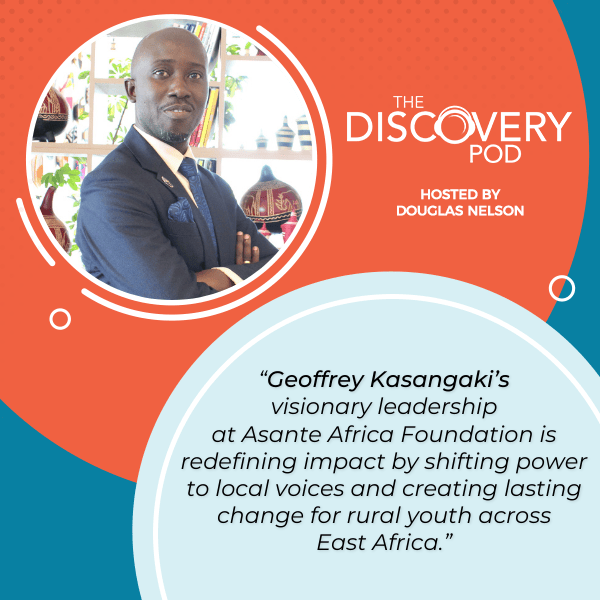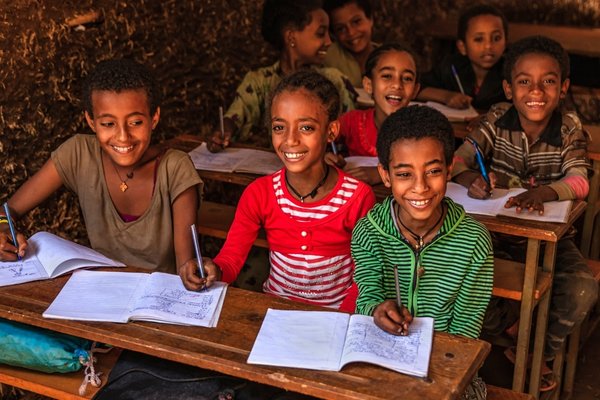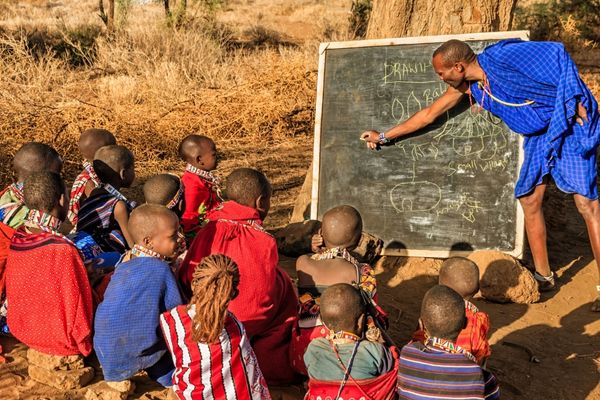
Building resilient social profits starts with leadership that empowers. Geoffrey Kasangaki, CEO of Asante Africa Foundation, shares how the organization equips rural youth in East Africa with the skills and mindset to transform challenges into opportunities. From innovative “pay it forward” models to robust governance and a bold transition of leadership from the global North to the global South, Geoffrey reveals the strategies that sustain impact even amid shrinking donor markets and operational challenges. Learn how Asante Africa Foundation measures success through lives transformed, not just numbers reached, and why their long-term vision focuses on local ownership, data-driven decisions, and strategic partnerships.
—
Listen to the podcast here
Building Resilient Social Profits With Geoffrey Kasangaki, CEO, Asante Africa Foundation
Let me say this episode is one of my favorites. Our guest is Geoffrey Kasangaki, the CEO of Asante Africa Foundation, where he previously served as deputy to the CEO and as Country Director in Uganda. He co-founded Asante Africa Foundation, Uganda and has led projects focused on equipping young people with the skills, confidence and opportunities they need to thrive in their communities and in the global economy.
In our conversation, he talks about the very thoughtful multi-year process to transfer the leadership and governance of the organization from the global North, to the global South and East Africa and the three countries in which Asante Africa does its important work. I also want you to listen to how he talks about the impact and the outcomes of their organization focusing very much on having meaningful reach and not just reach and impact. It is a powerful lesson in leadership and an exciting example of what can be done with great planning, great execution, and a brilliant idea. Thank you for reading.
—
Welcome to the show, Geoffrey.
Thank you, Douglas, and thank you for hosting me.
It’s wonderful to have you. You’re in Kampala, Uganda as we’re doing this. You’re sitting outside. It looks beautiful. What’s the weather like?
It’s been wet. Unfortunately, I had a fever but it’s something that I’m managing very well.
Let’s get into it. People who have been long-time readers of the show have heard from Erna Grasz, the founder of Asante Africa about the founding of the organization. We have a great adventure to talk about in terms of transitioning the leadership with the organization from the global North to the global South. I’m excited to get your perspective as CEO. As we get started, please tell our readers a little bit about Asante Africa and the great work that you and your colleagues do.
The question that drives me to Asante Africa whenever I’m asked that question is the focus on most marginalized communities of East Africa where we believe that there is high potential within the young people. They never have the opportunity and the platform and the right skills that are needed for them to drive and build striving communities.
Asante Africa exists to equip the young people in Rural East Africa. That’s Uganda, Kenya and Tanzania, giving them the right knowledge and the right skills that equip them or prepare them to strive and also build striving communities by looking at how they look at challenges or opportunities for them to strive.

Social Profits: Asante Africa Foundation exists to equip the young people in rural East Africa with the right knowledge and skills to thrive and build thriving communities.
I always say that the difference between the developed countries and developing countries, for the helping countries they present a lot of opportunities because everything looks to be a challenge but the young people need that small ignition for them to identify those challenges and make them opportunities.
Asante Africa Foundation: From Programs To Powerful Success Stories
That is a refreshing way to look at the problems of the world no matter where you live. One of the things that’s fascinated me is Asante Africa is an organization that my partner Allison has been involved with for many years and certainly, we’ve watched the organization very closely. How you meet that and how you create that spark for the young people in Rural East Africa has changed over time, so the types of programs that you offer. Give us a sense of where the programs are at and if you have a minute, where they’ve come from?
I’m happy to talk about that. Where I’m coming from, is that for years, what we are literally celebrating. By that time, we close our strategic plan in 2025, we will have reached approximately 1.6 million lives, cumulatively as an organization. That’s how great the impact is. What makes it extremely impactful is the number of stakeholders who are engaged along this journey because Asante Africa does not only reach the child but it’s how we prepare the communities to sustain these programs.
What makes it extremely impactful is the number of stakeholders engaged. Asante Africa Foundation doesn't just reach the child, but prepares communities to sustain these programs. Share on XWe get all the stakeholders on board such that beyond Asante Africa, these programs can be owned and for these programs to be owned, what do we talk about? We talk about digital skills because there is a very big gap that exists between the urban and the rural. When we are talking about the rural areas, there is very poor infrastructure that cannot even support digital devices. We work with the schools, the parents and the government stakeholders, whereby there is what you could call the cost-sharing bit.
We share the gadgets and then the schools are equipped with either solar panels to run these devices or they are connected to the grid such that the people are able to continue learning then we equally have an opportunity around entrepreneurship. The young people need to be provided with an alternative pathway to education. Not everyone goes through education. That education can only be the only way to succeed. They need to map out alternative pathways.
The alternative pathways that have come out of our programs are basically around three. We’ve seen the young people who are continuing with their former education. They are getting to universities and graduating. We’ve seen the young people who are taking on their entrepreneurship path where they are starting small in school and community projects. Later, these projects grow into big enterprises, then we equally have those ones who are taking the job or taking track. Whereby we see applying for jobs and becoming very competitive after going through our programs. They have the skills that enable them to succeed in interviews and also the much needed skills in a workplace that employers need.
I imagine over the years. You’ve got some powerful stories of success.
We’ve had very powerful stories of success like in Tanzania. We have a young man called Lajpal Ali, who was picked from a community and at risk of dropping out of school from analyst stage. Now, he’s a medical doctor who is supporting many people in Tanzania. That is the change we would desire to see in the communities.
We have a young girl who has been over in the Netherlands who secured a scholarship around Animal Science. She’s back and she’s training us on better ways of managing domestic animals. These are some of the changes that you want to see. People have seen how young people take on the leadership path. We had young people participate at the YALI Network. We’ve seen some of them coming out and turning out to be leaders across East Africa.
Also, receiving a lot of international recognition for the work of the programs that the students themselves, participants in your programs as well as Asante Africa. One of the heartwarming stories of 2024 was the students got the chance to meet King Charles. That was big news in Canada because we were just excited to have a new monarch.
This is exciting. It’s not only 2024 but even in 2025. In 2024, we had the opportunity to meet King Charles, which was good news, but it is not about us as an organization. It is about the impactful work that our program participants are able to undertake and create real community solutions that tackle global challenges. We’ve seen our young people get into activities that address global challenges on gender, climate, action and how we transform the communities to build shriving communities.

Social Profits: It is not about us as an organization. It is about the impactful work our program participants undertake to create real community solutions that tackle global challenges.
I’m feeling like this is a great opportunity to talk about the impact that the young people are making. Even in 2025, beyond King Charles in 2024 witnessing this story in Kenya. We’ve seen him celebrate two unique individuals Alice over Turkana and then Pascal over in Uganda. Pascal is so much climate action. He turns the plastic waste into things that become value for decoration in homes and then others become containers that we can use. He has turned plastic waste into an opportunity for him to shine but also people look at these items that are made from plastic waste as something that he brings joy in a home or brings decoration and attracts these people who come to visit a home.
Measuring Success: Impactful Reach Vs. Mere Reach
It’s a pleasure listening to you talking about that using the individual’s names, the students names, the participants and the successes they’ve had. You’ve been involved with the organization for quite a long time. How do you measure your success as a leader in the organization?
Measuring my success as a leader in the organization, I usually talk jokingly and ask, would you want to report about impact an reach or impactful an reach? To me, it is not about how many lives have been able to reach. It’s more about how many lives we have been able to touch and create a lasting impact that lives have been transformed. They are creating opportunities for some other youth within their communities like their initiative is able to accommodate other people to train through our pay it forward model.
It's not about how many lives we reach, but how many we touch, creating a lasting impact that transforms lives. Share on XOther people are able to come and be employed at the same enterprise. They are earning something from that enterprise and equally, it is creating a change within the community. In a nutshell, I look at what impact have we been able to create as an organization and it is evident. I love evidence as opposed to reach.
Thinking that impactful reach rather than just reaching an impact. I like that as a way of phrasing it. You mentioned something that I want to go back to and get you to talk a little bit more about. You mentioned a pay it forward model. What is that?
The pay it forward is a very unique model that is very unique to Asante Africa. It is one of the most treasured things that keep igniting my spark around Asante Africa. How one individual’s life impacted can transform a given society. When we are talking about one life reaching an impact in the entire society, we are talking about this one life you were able to reach, equipping them with the knowledge and with the right skills. They’ve been able to train other people beyond the direct intervention of Asante Africa.
This individual was ahead to train more people. It is more like you don’t need to be mean with what you know as it can help another life differently from how it has impacted you. It’s encouraging these young people to share their knowledge. That brings about another unique aspect that is the learn to teach model. That’s where the ripple effect comes from for Asante Africa beyond pay it forward. We have someone learning, then they have hands-on practice and then they are training others.
The aspect of training others helps that this skill becomes part of the DNA. If they keep it to themselves and they are not training any other person, it is just to them or at some point they could even forget about it. When you start training another person, you feel like you are turning to be a professor. For your first lecture in a four corner classroom, you may have taken lots of nights preparing how the lesson is going to be conducted and other. After doing it and training several people for over a period of time, these are the people we see stepping in class minus any paper and other. They’re able to go through the lessons successfully.
Operationalizing Impact: Challenges And Solutions In Program Delivery
It’s powerful and the ability to replicate that across the three countries in East Africa in these rural areas. When you describe it, it sounds obvious in a very straightforward way, like, “This is what we do. This is why we do it.” I imagine that it’s not that straightforward, Geoffrey. As the organization has expanded, what have been some of the operational or organizational challenges related to the program delivery that you and your colleagues have been facing?
As you said, it’s not a bed of roses but it starts with how we set it up for success. Setting it up for success, stakeholder engagements are very important because we must achieve buy-in minus buying or whatever will be talking about. It does not succeed. When we are talking about the challenges, we have to equally talk about how to mitigate the anticipated challenges. The mitigation is at a program launched who is on board supporting this program because you must take care of what the end is like.
One life impacted can transform a given society. Share on XYou cannot stay in one community and you say you’re successful. Our programs run on a three-year phase. The first year is the launch stage. We are launching and we are looking for buy-in from the stakeholders and the schools that we are partnering with. We are signing the MOUs that define the responsibilities of the organization, the responsibilities of the government and the responsibilities of the school. After all that process has been done and the expectations have been defined, we launched this program.
Launching the programs is not about looking at that, it is just within the hands of the school because we’ve not intended our programs to be more of a lecture best method whereby the children or the youth will lose interest. We take them through processes where we equip them with the skills to lead, to facilitate and to discuss and they’re making dialogues between themselves. They are able to share freely.
These clubs are facilitated by the young people themselves through peer mentors who have gone through training and supported by teachers who become club mentors. In any additional support that is needed, it is coming from the teacher as a mentor and keeping a relationship between the club that has been established within the school and also the school, what the relationship looks like between them.
We are equally looking at the second year. It’s the actual implementation year whereby our programs are fully rolled out and we understand how the clubs are conducting the activities and they master. The study year is the sustainability year. We start preparing the club beyond Asante Africa and we are measuring several things. Is there an opportunity for this club to continue beyond Asante Africa? Has the school appreciated the skills that come with it and opportunities that come with Asante Africa?
Are the government authorities able to absorb these programs to stay within the communities? It creates an opportunity not to limit yourself in a given environment when the actual services are still needed in other communities that are in need. That is bad but, again, away from the programs that are catering for that, we are looking at the challenges around resource mobilization.
You very well know that the market is shrinking and there are a lot of pressures that are coming in. We are seeing blocks beginning to build up across the world. Whereby how do we tackle these challenges? How do we belong to some of our networks that could build our source mobilization plan? How do we create some avenues locally in each of the countries to raise these resources? There have been tremendous cuts from the US. We’ve had tremendous cuts in Europe. All these mean a lot regarding program delivery.
When we are looking at program delivery, we are engaging a lot of volunteers coming in and working with us and sharing their skills, such that we continue to reach these young people. We are also looking at how we mobilize locally to continue running. We are taking a shift in terms of how we raise more resources locally to complement what we are getting from the rest of the world for these programs to continue.
Adaptability And Rigor: Tailoring Programs For Diverse Communities
It’s just that straightforward. I’m curious. As you are so anchored in the communities, you’re building that credibility and that permission, that social license to operate within these communities in that first year. How different do the programs look from one community to another when you get to that third year?
There are a lot of variances operating in three different countries. The three different countries present different dynamics. It equally explains the different innovations or results that you could be seeing coming from the different countries. For instance, when we are talking about Tanzania. The main language of instruction is Swahili. When they are going or transitioning into secondary, then they have a lot of automatic twists to English, which sometimes could compare some of their learners to drop out of school and others.
Asante Africa came up with an initiative that we call bridge the gap. Bridge the gap mainly focuses around the stem to prepare these young transitioning adolescents to go successfully into secondary and continue with their education. That is an initiative around Tanzania, but it equally varies when we get into the third year. There are some schools or communities that you’ll find they need an extra year for them to succeed. That is a consideration that the organization takes.
We do an evaluation for all the schools and communities we are working in. The data shows they all are at different levels. There are those ones which are extremely ready. They are able to continue beyond Asante Africa. There are those ones which are still moderate and still need some minimal support to get there. There are some communities and schools that will need an entire extra year to prepare them for life beyond Asante Africa.
In listening to your description of this, there is a lot of rigor in the process and a lot of flexibility in the implementation. Is that a fair way to say it? You recognize there is an end result you’re driving for. There is a system of starting these programs that you have confidence and evidence to back up. You and your colleagues understand that they will look differently in different communities whether it’s different regions of the same country or certainly in one of the three countries where you’re operating.
You are very right. That’s why a robust monitoring and evaluation system is very important for us. Our decisions are data-driven. Data is a very important asset for us to make a decision in the organization before schools and communities graduate from our programs. We are not a touch and go organization. We need to measure whether our presence has made a difference in that community. Whether our presence has made a difference in someone’s life or we are living in a community that is preparing itself to strive or it is already striving.

Social Profits: Our decisions are data-driven. Data is a very important asset for us to inform organizational decisions.
From Global North To South: Asante Africa Foundation’s Governance Transition
I want to transition a conversation a little bit because you have been with your organization for a number of years. You transitioned to being the CEO in October of 2024. In our work at The Discovery Group, we do a lot of work with governance, a large social profit and charitable organizations. We know that the transition from founder to post-founder is fraught with much danger and a lot of organizations don’t make it.
One of the things that I wanted to have you on to talk about, I was excited about this conversation, is not only have you been that leader that’s taken over from them, an iconic founder. Your organization’s also made a significant shift in where governance lies. Moving from the global North in North America primarily to the global South. You shared, as we were getting ready, a statistic about the number of organizations that have tried to make that North to South transition. Maybe start there and talk a little bit about the process of transitioning first the governance and then we’ll get into the CEO shift after that.
Number one, I need to trust and appreciate this step that the board took in terms of how do we ensure that this organization lives beyond the default, which is a good thing because high impact organizations need to outlive founders. Asante Africa is one of the high impact organizations. For the years I’ve been around, I’ve been so much accustomed to the stories that come from the young people. I know that there is a very strong plan around the organization on how we build a strong governance structure.
High impact organizations need to outlive founders. Share on XLooking at the strong governance structures we are an alliance of organizations. Being an alliance of organizations presents a very unique opportunity whereby we have governance at every country level organization. Beyond the country level governance there is what we call the country chair coordinating committee that brings all the chairpersons of the different countries together to form that part of what are the issues that are being handled at that level which still keeps the block together. We also have what we call the global alliance board.
The global alliance board is what brings all the participants together and forms a common agenda around the alliance. That presents a very unique opportunity for organizational continuity and there is a check at every level for this organization to strive in its governance system. This does not mean that it comes out so easy. We need to build it out for everyone to understand it.
For now, like the last few years when we’ve done this, it looks like it’s a very promising system that could hold this organization together beyond what we are planning, and how we continue this organization beyond the founder. These are some of the structures that have been built at the governance level to make sure that there is a healthy organization that we have built.
You mentioned the transition process has been a couple of years but the planning of that transition goes back many years before that if I’m not mistaken. Is that right?
Yes, it goes on for about five years. It was an entire plan within the strategic plan.
The reason why I wanted to draw that out, Geoffrey, when organizations are looking at significant changes, whether it’s in leadership or in their governance structure. We know what we want to do. Let’s hurry up and get there and organizations can move too quickly. There is a value on speed and we can be efficient even. We can use a lot of good business words, but when you move too quickly and you don’t bring everyone along. Those new structures that are set up or those new leaders that are put in place struggle to be successful. A five-year plan within a strategic plan is still moving pretty quickly from my perspective. Did it feel quick to you?
Challenges And Opportunities: Navigating The Transition To Local Leadership
I cannot say extremely quickly because that is the time it was reflected in the strategic plan but I believe it was a conversation that was always going on because from the conversations that we’ve had, the founder from the advent of this organization knew that she was building an organization that would be East Africa led. That was even before Geoffrey got to know about Asante Africa. I don’t think it was part of that. Later, when I joined Asante Africa and participated in its programs, I never knew that this conversation was already in the pipeline of Asante Africa.
Within the five years strategic plan and being an executive, when I launched the Uganda organization and then taking it through the pandemic where we achieved very great results and then also the leadership style and all that. It was part of the conversations which were informal then and the five-year strategic plan became extremely formal. The organization was looking at, is it internal or external? How do we make sure that this organization continues?
There were a series of interviews that were conducted and very many people applied for this role. I cannot say like I stood out to just succeed the founder but I went through a very rough process of interviewing. I know that a deal or a decision was made that said, “We think he understands this organization and there is a possibility that this organization can continue with Geoffrey.”
That’s how I got into the picture but after a very rough process of interviewing several candidates and there were very many top candidates. It depends on what the organization is looking out for at that material because you might be of content at that time but how you position the organization beyond what you can offer for it to succeed in terms of beyond the founder.
You said through this process, you had looked at the date of organizations that tried to shift their governments from the global North to the global South. What was the statistic you said?
Organizations that try out to succeed to do this only two succeed, is 10% success.
As somebody who’s leading a data-driven organization, that’s not very high.
It’s extremely risky. If you ask me, I would say it’s a risky process. It is not well managed. That’s why I was talking about Asante Africa. The process started a long time ago. Having the right people in the governance structures and also looking at the managing recruitments at management level during that time, building out succession plans and also the mentorship plans for your executives is equally important. Even though I’m leading this transition, my challenge is how I prepare the organization beyond Geoffrey. I cannot count myself as successful if I have no succession plan.

Social Profits: I cannot count myself as successful if I have no succession plan.
There are so many leaders that we work with here at The Discovery Group that need to hear that message. That’s a powerful measure of success. The story of Asante Africa, both that’s founding and this transition that you’ve been so intimately involved with is such a positive example for the social profit sector in organization that evolved was wanting to be rooted in community with that long-term goal of being governed in the country and it made it.
One of the theories I have about work in our sector wherever we are in the world is that most people are good. Most systems are problematic or bad. Bad systems cause good people to do bad things. You need to have good people and good systems. As you’ve been through all of this transition and as you’re looking forward, what would you say the balance is between needing those good systems and having those good people?
People And Systems: Balancing Human Impact With Organizational Structure
The best part for me is to blink more of the organization at the time of the transition. A lot of things like the way we do business and all that, several things have to change. They are also looking at how the countries respond and the executives that respond with this transition is equally important. Douglas sitting over in Canada is not the same way as Geoffrey sitting where the work is being done. It means every day I’m in touch with the reality of you and having very many different conversations because even the time zone can deprive you of that opportunity.
Now, I have another opportunity to have this conversation. What we are looking at is mainly around assessments. How do we look at our HR or our systems or what needs to change? There are several things that we have been able to change during this transition. Over the last few months, there are several things that have changed but they are those ones that are going to continue changing. We are having a very strong organization that is well managed but we are not losing that true vision of a young person being at the center of whatever we do.
Let’s not deviate the organization from the original principle of, whom we touch, why we exist, what’s our vision, and what’s our mission. These remote communities continue to exist in any part of the world and they continue to be wanted. They continue to need opportunities and need us as Asante Africa as much as other organizations because we cannot be everywhere.
One unique statement that my predecessor used to tell me when I had just joined is, “You get to a community, you’ve supported this household where everyone is struggling and all that. As you’re moving one kilometer away, there is someone who is bad luck.” You’re like, “I think these ones are now worse than the first group that we did.” she used to say, “Geoffrey, as he continued doing this work, knew there is need everywhere and you cannot do everything.” That brings about our pay it forward and how the one life you’ve been able to touch can also impact the other family that you are not able to reach. It becomes a very easy way.
The organization has already done a diagnosis, knows where the gaps exist and knows how we are going to address them. Most especially when we just had the globalized board meeting. It could point out our opportunities and threats. One of the biggest opportunities that we have is a locally-led organization that they envisioned from the offset of Asante Africa.
The Road Ahead: Strategic Vision For Asante Africa Foundation’s Future
I love it. As we come to the end of our conversation, I get to ask my favorite question. Geoffrey, what are you looking forward to?
That is a very interesting question and most especially at a time when I’m developing the next strategic plan. I’m looking at how I reach an addition of 250,000 extra young lives directly. That is the task I have ahead. Looking at these people or the youth, I’m looking at how they build shriving communities. How are they empowered through our programs equipped with the knowledge and the skills that they need for them to get and gain full employment, can compete and pass the interviews and get the jobs and create enterprises for alternative pathways into livelihoods? How do I improve livelihoods at a household level? These are things that I would love to celebrate at the end of the strategic plan in the next five years.
I want us to be known by our impact as an organization, not just by the logo. Share on XThe other thing that I’m looking forward to because I’m just giving is how beautiful the body of the car looks. I’ve not talked about the engine. How do build the revenue best through diversified funding that could complement. the 250,000 lives that are planning to reach. Minus the fuel, the 250,000 lives could just be a word of mouth but not reality. I look at how we build the revenue best and how we build all these important strategic partnerships that can help us grow faster.
You talked about the king meeting our young people. How do we build celebrated partnerships like the King’s trust international that should move a little faster in achieving these lives? We have another celebrated strategic partnership over in Tanzania with Imagine Worldwide that is helping us grow a little faster. These are some of the things we need to think about strategically to make sure that this organization continues to strive.
I wish readers could see the look on your face as you describe the next five years. You’re describing these enormous challenges with a big smile on your face. It is great to hear. Geoffrey, I have so much respect for the work that you do and you have done. Many individuals working in the social profit sector wherever they are in the world have a lot to learn from the work that you and your colleagues have done over the last few years and be inspired by the work you’re going to do over the next five.
I’m always extremely inspired and challenged by the work of Asante Africa. When I’m asked, “Where do you work?” I always say, “I serve in Asante Africa.” I do not see myself as working at Asante Africa, but service to the young people or to the community. That is the opportunity that Asante Africa has presented me with. I equally look at it in a way of, as an individual, how do I want to be remembered? When I step into a hospital in my old age, is there an alumni of Asante Africa who looks at the name Geoffrey Kasangaki and says, “If it was not for Asante Africa, I wouldn’t be here and Geoffrey who is waiting on the line.”
That’s where the self-interest is just skip the line in old age.
I feel like in my line of service, that is when I’m turning 50 or 60, I should be able to be meeting these lives and they say, “This is Geoffrey,” or I need some support coming from the government. I have a top executive serving in government who has been part of Asante. If Asante Africa beyond Geoffrey is needing a service from the government, I just want to build an organization where someone feels a request for information form.
Someone just sees Asante Africa and says, “Please, if this person is from Asante Africa, let them come in. I know the work that they do.” I want us to be known by our impact as an organization. Not just by the logo’s and all that. It is good to identify me by the logo so that you can see me but what you remember me about is the best part.
You are well on your way. Thank you for all that you do every day, Geoffrey and for being on the show.
Thank you so much and thank you for hosting me.




